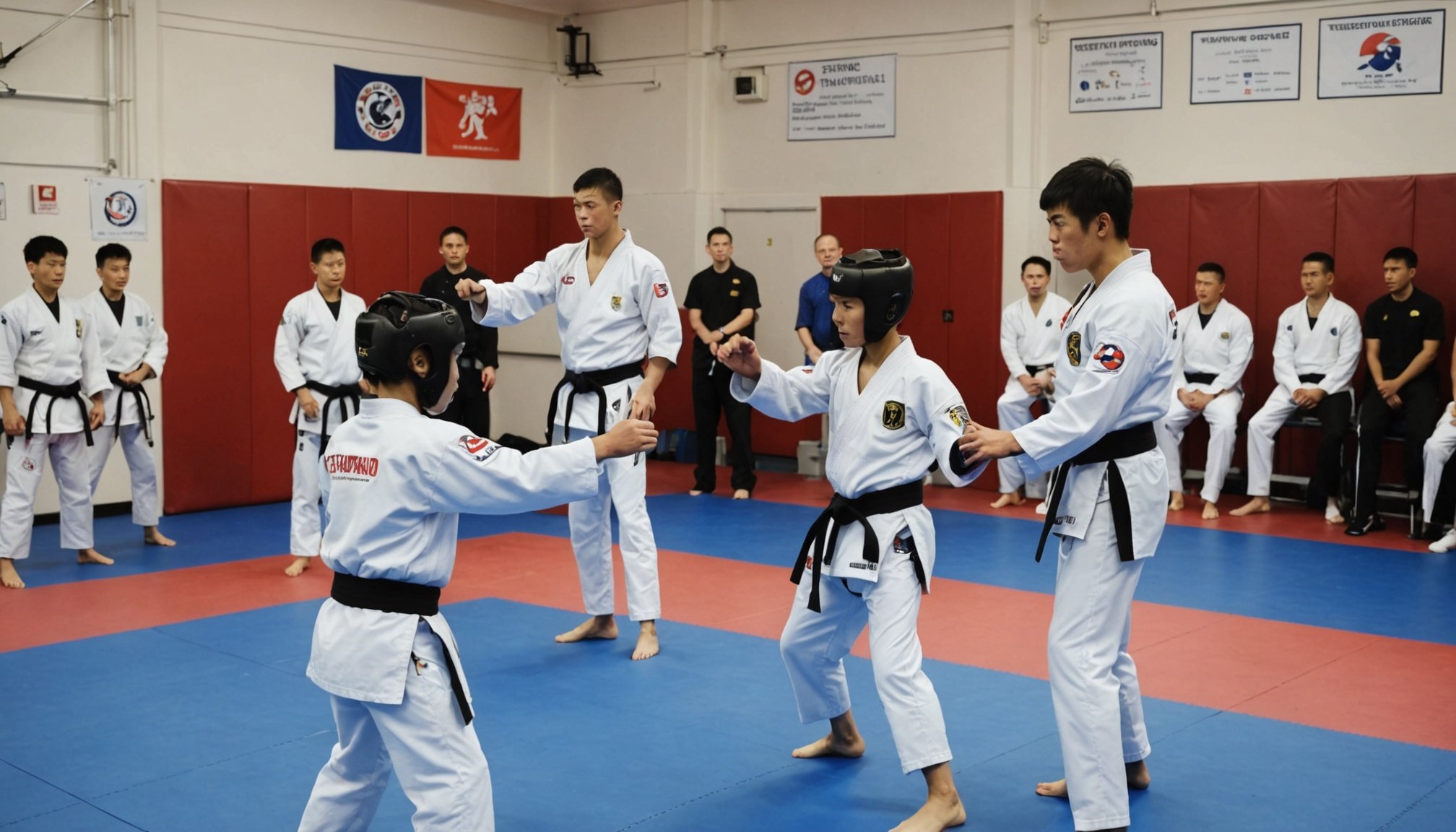Essential Safety Guidelines for Sparring in UK Taekwondo Clubs: Protecting Practitioners First!
Understanding the Importance of Safety in Taekwondo
Taekwondo, a martial art known for its high-energy kicks and punches, is a popular sport in the UK, attracting practitioners of all ages. However, like any contact sport, it comes with its share of risks. Ensuring the safety of practitioners is paramount, and this is where stringent safety guidelines come into play.
The Role of Martial Arts in Safety Training
Martial arts, including taekwondo, not only teach physical techniques but also emphasize situational awareness and self-defense skills. For instance, training outdoors versus indoors requires different levels of situational awareness due to varying terrain conditions. Practitioners must be aware of the ground’s surface to maintain balance and avoid injuries such as ankle sprains.
Also to discover : Exploring the Hottest Aerobic Conditioning Trends for Kickboxers in the UK
Personal Protective Equipment (PPE) – A Must-Have
One of the most critical aspects of safety in taekwondo sparring is the use of personal protective equipment (PPE).
Mandatory Gear for Sparring
For any sparring competition, the following PPE is mandatory:
Also to read : Top Breathing Techniques for UK Karate Competitors: Boosting Performance and Focus
- Body Protector: Red or blue, depending on the competitor’s side.
- Arm Guards
- Shin Guards
- Head Guard: Red or blue, matching the body protector.
Why PPE is Crucial
PPE significantly reduces the risk of injury during sparring. For example, head guards protect against head injuries, which are common in full-contact sports. Arm and shin guards prevent bruises and fractures. The body protector safeguards the torso from kicks and punches.
Medical Provision and Risk Management
Medical provision is another vital component of safety in taekwondo clubs.
Medical Staffing Requirements
The British Student Taekwondo Federation (BSTF) has strict guidelines for medical staffing at tournaments:
- For every 5 concurrent sparring courts, there must be at least 4 medical staff, including paramedics or advanced emergency aid qualified personnel.
- Medical staff must be dedicated solely to the event and not include general venue staff or umpires.
Risk Assessment and Mitigation
Risk management is a multi-layered approach:
- Weight and Grade Divisions: Ensuring competitors are matched according to their weight and experience level reduces the risk of injury.
- Trained Umpires: Umpires play a crucial role in enforcing competition rules and identifying potential injuries early.
- Jigsaw Matting: Using jigsaw matting with a minimum boundary area of 9×9 meters per court helps reduce the risk of injury from falls.
Training and Competition Rules
Adhering to specific training and competition rules is essential for safeguarding practitioners.
Sparring Rules and Modes
Before any sparring session, it is crucial to clear any specific rules, such as “No Grappling,” and check for current injuries to avoid contact. The mode of sparring must be decided and agreed upon by all participants.
Grade Divisions and Experience Levels
Competitors must enter disciplines according to their grade and experience level:
- C-Class: Novice, approximately <1.5 years of experience
- B-Class: Mid-level, approximately <2.5 years of experience
- A-Class: Senior, >2.5 years of experience
- Belt Kup System: Competitors must not enter a division lower than their highest taekwondo grade awarded.
Safeguarding Adults and Children
Safeguarding is a critical aspect of any martial arts club, ensuring that all members, especially children and vulnerable adults, are protected from abuse and neglect.
Policy Procedures and Care Act
Clubs must adhere to strict policy procedures, including those outlined by British Taekwondo and the Care Act:
- Safeguarding Policies: Clubs must have clear policies in place to prevent abuse and neglect.
- Training for Instructors: Instructors must undergo safeguarding training to recognize and respond to poor practice.
Practical Tips for Safe Sparring
Here are some practical tips to ensure safe sparring sessions:
Warm-Up and Cool-Down
- Always warm up before sparring to prevent muscle injuries.
- Cool down afterwards to reduce muscle soreness.
Communication
- Communicate clearly with your sparring partner about any injuries or discomfort.
- Use verbal techniques to de-escalate situations if they become too intense.
Situational Awareness
- Practice situational awareness to anticipate and respond to changing situations during sparring.
- Use peripheral vision to stay aware of your surroundings and your partner’s movements.
Seeking Help and Reporting Incidents
Knowing when and how to seek help is crucial in maintaining a safe training environment.
Reporting Incidents
- Any incidents or injuries must be reported immediately to the instructor or medical staff.
- Clubs should have a clear procedure for reporting and handling incidents.
Yelling for Help
- In situations where you need immediate assistance, yelling or screaming can attract attention and help.
- This technique is practiced in many martial arts to temporarily shock and stun an opponent while seeking help.
Table: Comparison of Safety Measures in Different Taekwondo Competitions
| Safety Measure | BSTF Competitions | General Taekwondo Clubs |
|---|---|---|
| PPE Requirements | Mandatory body protector, arm guards, shin guards, head guard | Recommended but not always mandatory |
| Medical Staffing | At least 4 medical staff for every 5 sparring courts | Varies, but ideally includes trained first aiders |
| Weight and Grade Divisions | Strict divisions based on weight and experience | Divisions based on club policies |
| Trained Umpires | Mandatory trained umpires | Recommended trained umpires |
| Matting and Flooring | Jigsaw matting with minimum 9×9 meters boundary | Varies, but ideally includes safety matting |
| Safeguarding Policies | Strict policies in place, including Care Act adherence | Policies vary by club, but safeguarding training is recommended |
Quotes from Experts
- “Situational awareness is key in sparring. It helps you anticipate and respond to changing situations, making the session safer and more productive.” – Pacific International Taekwondo.
- “Medical provision is not just about having someone with a first aid kit; it’s about having trained medical staff who can handle serious injuries.” – BSTF Medical Provision Guidelines.
Safety in taekwondo sparring is not just a set of rules; it’s a culture that needs to be embedded in every club and training session. By adhering to strict safety guidelines, using the right PPE, ensuring adequate medical provision, and following competition rules, we can protect our practitioners and ensure a safe and enjoyable training environment.
Final Tips
- Stay Informed: Always read and understand the safety policies and procedures of your club.
- Communicate: Keep open lines of communication with your instructor and sparring partners.
- Practice Safely: Follow all safety guidelines and use common sense during training.
By taking these steps, we can ensure that taekwondo remains a safe and rewarding martial art for everyone involved.











